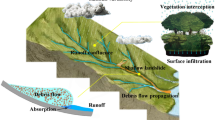Abstract
In the Indian Himalaya, a 15 km stretch of the North Sikkim Highway that is exceptionally susceptible to landsliding is characterized by fine-grained, low permeability debris material. Lanta Khola is one of the major debris slides in this stretch and is active every year during the monsoons. Although the relationship between rainfall and landsliding in the area is obvious, there is no previous study of precipitation thresholds for landslide initiation. Review of available rainfall and landslide activity data for the area between 1998 and 2006 suggests that sliding cannot be modeled by typical exponential relationships between cumulative rainfall (E) and rainfall duration (D). An alternative rainfall threshold has been proposed that predicts sliding if normalized cumulative rainfall for more than 15 days exceeds 250 mm. It is suggested that when this cumulative rainfall threshold is exceeded, the debris zone in the affected stretch becomes saturated and fails, causing landsliding.






Similar content being viewed by others
References
Aleotti P (2004) A warning system for rainfall-induced shallow failures. Eng Geol 73:247–265. doi:10.1016/j.enggeo.2004.01.007
Anbarasu K, Gupta S, Sengupta A (in press) Site specific geological and geotechnical studies on the Lanta Khola landslide, North Sikkim Highway. India Int J Geotech Eng
Bhandari RK, Senanayake KS, Thayalan N (1991) Pitfalls in the prediction on landslide through rainfall data. In: Bell DH (ed) Landslides, 2nd edn. A.A. Balkema, Rotterdam, pp 887–890
Caine N (1980) The rainfall intensity-duration control of shallow landslides and debris flows. Geogr Ann A 62:23–27. doi:10.2307/520449
Campbell RH (1975) Soil slips, debris flows, and rainstorms in the Santa Monica Mountains and vicinity, southern California. In: US Geological Survey Professional Paper 851. US Government Printing Office, Washington, DC, 51 pp
Cannon SH, Ellen SD (1985) Rainfall conditions for abundant debris avalanches, San Francisco Bay region, California. Calif Geol 38:267–272
Cardinali M, Galli M, Guzzetti F, Ardizzone F, Reichenbach P, Bartoccini P (2005) Rainfall induced landslides in December 2004 in South-Western Umbria, Central Italy. Nat Hazards Earth Syst Sci 6:237–260
Chleborad AF (2003) Preliminary evaluation of a precipitation threshold for anticipating the occurrence of landslides in the Seattle, Washington, Area. US Geological Survey open-file report 03-463
Corominas J (2000) Landslides and climate. In: Bromhead E, Dixon N, Ibsen ML (eds) Keynote lecture of proceedings of 8th international symposium on landslides, vol 4. A.A. Balkema, Cardiff, pp 1–33
Crosta GB, Frattini P (2001) Rainfall thresholds for triggering soil slips and debris flow. In: Mugnai A, Guzzetti F, Roth G (eds) Proceedings of the 2nd EGS Plinius conference on mediterranean storms. Siena, Italy, pp 463–487
De Vita P (2000) Fenomeni di instabilità della coperture piroclastiche dei monti Lattari, di Sarno e di Salerno (Campania) ed analisi degli eventi pluviometrici determinanti. Quad Geol Appl 7(2):213–235
Edris Earl V, Wright SG (1992) UTEXAS2, slope stability package. Instruction Report GL-87-1. Department of the Army, US Army Corps of Engineers, Washington, DC, Contract No. DACW39-89-C-0024
Gabet EJ, Burbank DW, Putkonen JK, Pratt-Sitaula BA, Oiha T (2004) Rainfall thresholds for landsliding in the Himalayas of Nepal. Geomorphology 63:131–143. doi:10.1016/j.geomorph.2004.03.011
Glade T, Crozier MJ, Smith P (2000) Applying probability determination to refine landslide-triggering rainfall thresholds using an empirical “Antecedent Daily Rainfall Model”. Pure Appl Geophys 157(6/8):1059–1079. doi:10.1007/s000240050017
Govi M, Mortara G, Sorzana P (1985) Eventi idrologici e frane. Geol Appl Ing 20(2):359–375
Heyerdahl H, Harbitz CB, Domaas U, Sandersen F, Tronstad K, Nowacki F, Engen A, Kjekstad O, Dévoli G, Buezo SG, Diaz MR, Hernandez W (2003). Rainfall induced lahars in volcanic debris in Nicaragua and El Salvador: practical mitigation. In: Proceedings of international conference on fast slope movements—prediction and prevention for risk mitigation, IC-FSM2003. Patron Pub, Naples, pp 275–282
Hoek E, Bray J (1981) Rock slope engineering. IMM, London
Jibson RW (1989) Debris flow in southern Porto Rico. J Geol Soc Am, Spec Pap 236:29–55
Kim SK, Hong WP, Kim YM (1991) Prediction of rainfall-triggered landslides in Korea. In: Bell DH (ed) Landslides, 2nd edn. A.A. Balkema, Rotterdam, pp 989–994
Pasuto A, Silvano S (1998) Rainfall as a triggering factor of shallow mass movements. A case study in the Dolomites, Italy. Environ Geol 35(2–3):184–189. doi:10.1007/s002540050304
Terlien MTJ (1998) The determination of statistical and deterministic hydrological landslide-triggering thresholds. Environ Geol 35(2–3):124–130. doi:10.1007/s002540050299
Verma PN (1984) Geotechnical report on September, 1983 landslide in North Sikkim. Geol Surv India, unpubl. report
White ID, Mottershead DN, Harrison JJ (1996) Environmental systems, 2nd edn. Chapman & Hall, London, p 616
Wieczorek GF (1996) Landslide triggering mechanisms. In: Turner AK, Schuster RL (eds) Landslides: investigation and mitigation. Transportation Research Board, National Research Council, Washington, DC, Special Report, pp 76–90
Wieczorek GF, Glade T (2005) Climatic factors influencing occurrence of debris flows. In: Jakob M, Hungr O (eds) Debris flow hazards and related phenomena. Springer, Berlin, pp 325–362
Wilson RC (1989) Rainstorms, pore pressures and debris flows: a theoretical framework. In: Morton DM, Sadler PM (eds) Landslides in a semi-arid environment, 2nd edn. Publications of the Inland Geological Society, California, pp 101–117
Acknowledgment
The authors gratefully acknowledge the financial assistance provided by the Department of Science and Technology of Government of India (Project No. ES/11/092(50)/2003). We are also greatly indebted to the Border Roads Organization (Project Dantak) for the unfailing logistic support provided during fieldwork.
Author information
Authors and Affiliations
Corresponding author
Rights and permissions
About this article
Cite this article
Sengupta, A., Gupta, S. & Anbarasu, K. Rainfall thresholds for the initiation of landslide at Lanta Khola in north Sikkim, India. Nat Hazards 52, 31–42 (2010). https://doi.org/10.1007/s11069-009-9352-9
Received:
Accepted:
Published:
Issue Date:
DOI: https://doi.org/10.1007/s11069-009-9352-9




